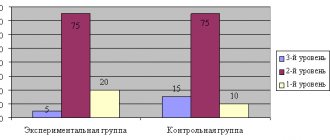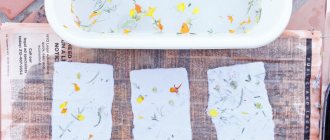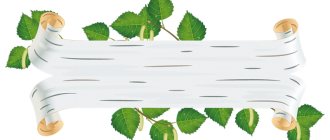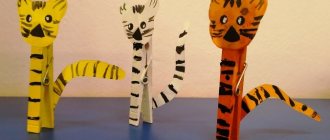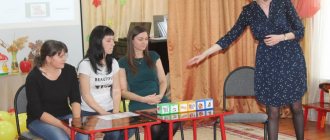Methodology for organizing morning receptions for young children.
Morning reception plays a big role in organizing a child’s positive mood . After all, his whole day depends on how a child is received in kindergarten. Often one child's bad mood affects other children.
A friendly meeting with their teacher affects their mood, performance, and discipline. If children know that they are expected to be welcome, they are more willing to go to kindergarten. An observant teacher sees in what mood the child came to kindergarten and shows pedagogical tact: either he immediately involves the child in activities, or gives him the opportunity to be alone and calm down. A child entering kindergarten for the first time requires special attention. The teacher occupies him with a toy, distracts him from sad thoughts, and strives to make the transition from home to kindergarten less painful. Reluctance to go to kindergarten sometimes manifests itself in those children who have been attending preschool for a long time. The reasons may lie in the child’s health, overwork, failure of adults to fulfill promises, etc. Sometimes parents, rushing to work, begin to undress the child, causing his protest, or, on the contrary, spend a long time persuading him. The teacher should talk with such parents, convince them that all this has a negative effect on the baby, affects his mood, and that after his loved ones leave, he cannot calm down for a long time. To quickly distract a child, you should switch his attention to something interesting. This can be done in different ways: give a small assignment, watch something interesting together, offer board games, didactic games. For example: 1) You can hide your child’s favorite toy in his cubicle in advance. 2) On the threshold of the group, attract the child’s attention with a toy and ask for help (feed, dress, wash, etc.) 3) Arriving at work in advance, you can build a house, put animals there and invite the child to play with you. 4) Get the child interested in an unusual toy , where he can show his imagination, tie, untie, fasten.
Children's work activities can be organized in the morning hours. At a younger age, the teacher involves children in caring for plants and animals (watering flowers, feeding fish), invites them to change clothes for a doll, etc.
Children carry out work assignments under the supervision of a teacher and with his help.
Ticket number 11
1. The importance of the game for preparing children for school. (2015, b.11 - different wording, but the essence is the same)
2. Forms and methods of interaction between the teacher and the parents of students. (2015, b.11)
Ticket number 12
1. General characteristics of the educational field “Socio-communicative development.” (2015, b.16)
2. Pedagogical conditions for the use of didactic games in the educational process of kindergarten. (2015, b.12)
1. Characteristics of the educational field “Social and communicative development”.
Federal State Educational Standards up to clause 2. Social communicative development is aimed at:
· appropriation of norms and values accepted in society, including moral and moral values;
· development of communication and interaction of the child with adults and peers;
· formation of independence, purposefulness and self-regulation of one’s own actions;
· development of social and emotional intelligence, emotional responsiveness, empathy,
· formation of readiness for joint activities with peers,
· formation of a respectful attitude and a sense of belonging to one’s family, small homeland and Fatherland, ideas about the socio-cultural values of our people, about domestic traditions and holidays;
· formation of the foundations of safety in everyday life, society, and nature.
— Formation of social and communicative speech skills (development of the ability to enter into communication and maintain it).
To solve the tasks, it is necessary to comply with a number of conditions
— use of health-saving educational technologies in the practice of preschool educational institutions;
— implementation of the general education program;
— enrichment of the subject-spatial environment.
The introduction of the Federal State Educational Standard for preschool education determines the nature of interaction between adults and children as personal developmental and humanistic. implying respect for the child, creating a friendly atmosphere of cooperation between children in the group, and orienting children towards universal human values.
Ticket number 13
1. Diversified education and development of the child in musical activities. Goal, objectives, content, forms, methods of work of the teacher, methodological support for the comprehensive development of the child in musical activity. (2015, b.13)
2. Modern educational technologies in the practice of preschool teacher work. (See distance)
1.Diversified education and development of a child in musical activities. Goal, objectives, content, forms, methods of work of the teacher, methodological support for the comprehensive development of the child in musical activity.
On January 1, 2014, the Federal State Educational Standard for Preschool Education, approved by Order of the Ministry of Education and Science of Russia dated October 17, 2013 No. 1155, came into force.
The first thing that should be noted after getting acquainted with the Federal State Educational Standard for preschool education is the orientation of the new document on the socialization and individualization of the development of a child aged from 2 months to 8 years.
Music and children's musical activity are a means and condition for a child’s entry into the world of social relations, discovery and presentation of his “I” to society. This is the main guideline for specialists and educators in interpreting the musical content of the program in accordance with the Standard.
The main content of the educational field “Music” is now presented in the educational field “Artistic and Aesthetic Development” along with the visual and literary arts. This is a big plus, since the division of the arts into educational areas made the process of integration difficult.
And in relation to a preschool child, this makes little sense at all; for us it is important to teach the child to communicate with works of art in general, to develop artistic perception, the sensory sphere, the ability to interpret artistic images, and in this all types of art are similar. They are distinguished by means of artistic expression; we may differ on these tasks, but in general, the purpose of any type of art is the reflection of reality in artistic images, and how the child learns to perceive them, think about them, decode the idea of the artist, composer, writer, director , depends on the work of each specialist and educator.
The educational field “Artistic and Aesthetic Development” involves:
ü development of prerequisites for value-semantic perception and understanding of works of art (verbal, musical, visual), the natural world;
ü formation of an aesthetic attitude towards the surrounding world;
ü formation of elementary ideas about types of art;
ü perception of music, fiction, folklore;
ü stimulating empathy for the characters of works of art;
ü implementation of independent creative activities of children (visual, constructive-model, musical, etc.).
Objectives of music education in various educational fields.
So, for example, regarding the educational field “Socio-communicative development” we are talking about the formation of ideas about the socio-cultural values of our people, about domestic traditions and holidays.
The educational field “Cognitive Development” involves the development of imagination and creative activity; the formation of primary ideas about oneself, other people, objects of the surrounding world, about the properties and relationships of objects of the surrounding world (shape, color, size, material, sound, rhythm, tempo, quantity, number, part and whole, space and time, movement and rest , causes and consequences, etc.), about planet Earth as the common home of people, about the peculiarities of its nature, the diversity of countries and peoples of the world.
In the educational field “Speech Development” we are talking about the development of sound and intonation culture of speech.
The educational field “Physical Development” involves the development of such physical qualities as coordination and flexibility; development of balance, coordination of movements, gross and fine motor skills of both hands; formation of focus and self-regulation in the motor sphere.
The range of tasks of musical education and child development in preschool childhood is expanding. These are tasks related to the child’s entry into the world of music, the development of musical erudition and culture of preschool children, the value attitude towards music as an art form, musical traditions and holidays. These are also tasks related to the development of the experience of perceiving musical works, empathy for musical images, moods and feelings, the tasks of developing the sound sensory and intonation experience of preschoolers.
Music acts as one of the possible languages for introducing children to the world around them, the world of objects and nature and, most importantly, the world of man, his emotions, experiences and feelings. Musical and motor activity, playing children's musical instruments, musical finger games, organized in music classes, develop the child's physical qualities, motor skills and motor abilities, and help in the development of self-regulation in the motor sphere.
Ticket number 14
1. Child development in visual arts. (2015, b.14)
2. The problem of a child’s psychological readiness for school.
Ticket number 15
1. General characteristics of the educational field “Speech development.” (2015, b.15)
2. Developmental possibilities of role-playing games. (2015, b.15)
GCD. Morning reception of children in the first junior group. lesson plan (junior group) on the topic
- Hello. Hello, …..How are you doing? How is Danis feeling? Don't forget to sign the report card. Goodbye.
Hello Adeline, what a beautiful dress you have!
Hello Eldan, how are you? Good? Great!
Children are given board games: large mosaics, puzzles, lacing, cubes.
Guys, let's go visit our flowers.
In our group on the window, in a green country
Flowers grew in painted pots.
Here is geranium, here is chlorophytum. Here is a planted onion.
We will water them early: me and all my friends.
…….. I took a watering can and watered all the flowers. Let the little flowers drink some water. I wiped the leaves with a soft cloth. ………The dust prevents me from breathing, it closes the pores. A geranium bloomed on the window so early. Round leaves, lush flowers. Even very good - that’s what the kids decided.
Children water flowers and planted onions. With the help of the teacher, wipe the leaves from dust.
After work, praise the children.
Musical game "Carousel"
Әылә-лә, Әйлә-лә, carousel әыләнә.
Matur kurchak әylәnә, matur ayu әylәnә,
Matur kuyan әılәnә.
The teacher has a toy butterfly in his hands. When the teacher says: “Day. Butterflies are flying,” the children wave their arms and dance, and when the teacher says: “Night. Butterflies go to bed,” the children squat down and close their eyes.
“The chicken went out for a walk”
The chicken went out for a walk, (They walk with two fingers - the index and middle - of each hand.)
Pinch fresh grass (Pinching movements with all fingers of each hand.)
And the kids follow her - (Run with all the fingers of both hands.)
Yellow chickens. (Clap their hands.)
“Ko-ko-ko, ko-ko-ko, (They shake the finger of the leading hand.)
Don't go far
Row with your paws, (Rowing movements with each finger of both hands at the same time, the thumbs fix the palms at the edge of the table.)
Look for grains." (Children collect grains alternately with two fingers of each hand or both hands at the same time: thumb - index, thumb - middle, etc.)
"Wheat pies"
We bake excellent wheat pies (first one hand on top, then the other)
Who will come to us to try wheat pies? (raise their shoulders up, spread their arms to the sides)
Mom, dad, brother, sister, shaggy dog from the yard. (bend the fingers on the hand, starting with the little finger)
And others, everyone who can, let them come with them too. (“they call with their hands, they stretch their arms forward”)
We put wheat pies in the oven. (press palms loosely against each other, extend straight palms forward)
The stove burns merrily (they quickly move their fingers, raising and lowering their hands)
Our mother says: (put their hands in a “shelf”)
- The crumbs that remain will go to the sparrow. (“crumb crumbs”, tap their index fingers on their knees).
